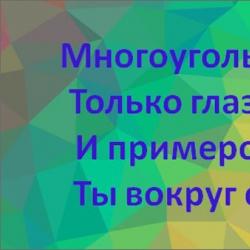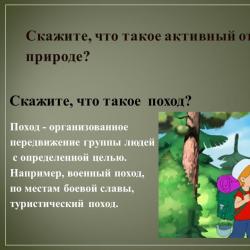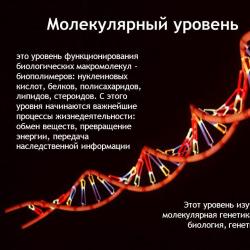Peoples of Siberia. Peoples of Siberia Text of this presentation
History lesson
in the 7th grade

- Repetition of the past. Checking homework.
- Exploring a new topic:
- peoples of Siberia (work with a contour map);
- Russian exploration of Siberia;
- explorers and their discoveries (messages from the guys).
3. Filling in the table.
4. Summing up the lesson.

- Let's speak clearly and loudly.
- Listen carefully to teachers and children.
- Repeat vocabulary.

Fill in the missing letters and explain what this term means.
1. At-man
2. M-nufacture
3. Self-d-rust
Simeon Polotsky - poet, educator

Fill in the correct letters for the gaps and explain what the term means.
1. At A man – leader in the Cossack army.
2. M A nufactura – a large industrial enterprise with a division of manual labor.
3. Himself O d e rusting – a form of government where the king has supreme power.

Alexei
Mikhailovich
Patriarch
Nikon
Michael
Fedorovich
archpriest
Habakkuk
S. Razin

1. In the 60s of the XVII century, the government began to issue money.
2. This was the reason
3. The uprising of the Cossacks on the Don led
4. The reason for the uprising was an attempt
break the principle
5. The uprising took place in years
"Copper Riot"
Stepan Razin
“There is no extradition from the Don”

- XVII century

… From century to century
There was a strong Russian man
To the far north and east
Unstoppable like a stream...
He went to unknown lands
While in the unknown distance
He didn't come to the ends of the earth
Where there was nowhere to go
Where across his path,
Dressed in storms and mist
A boundless ocean arose.
- “Where else is there such a distance, such a vastness? Land of lake freshness Generous, open to people. And so much sweet tenderness In all your severity.

- what peoples inhabited Siberia;
- how the development of Siberia by the Russians proceeded;
- what is the significance of the annexation of Siberia.


- What can you tell about Russia in XVII century



Siberia and its peoples


- What peoples lived in Siberia in the 17th century? p.83
- On the contour map, mark the places of settlement of the peoples of Siberia.


Udege



- Ermak Timofeevich- Russian Cossack chieftain, conqueror of Siberia for the Russian state.


- XVI century - the Cossack Ermak Timofeevich opened the way to Siberia for the Russians.
- XVII century - service people, Cossacks, hunters, merchants continued to explore Siberia.
- These people were attracted here by rich natural resources: gold and silver, expensive furs - soft junk , free land.
- On the way explorers built towns, prisons . Local Siberian tribes were part of the Russian state. It happened most of the time peacefully.
- Siberian residents had to pay to the treasury yasak , that is, a tax in furs.


- In Siberia, the settlers are spreading arable farming.
- Thus, Siberia learned to provide itself with bread on its own.

- Soft junk - expensive fur, furs
- Prison - a small wooden fortress.
- Yasak - tax on the local population. Surrendered furs.

- Ivan Moskvitin
- Vasily Poyarkov
- Semyon Dezhnev
- Erofei Khabarov.

1639 - Ivan Yuryevich Moskvitin went to the shores of the Pacific Ocean.


1648 - Semyon Ivanovich Dezhnev
opened the strait between Asia and America.

1649-1653 years - Erofey Pavlovich Khabarov made a big trip to the Amur. He annexed the Amur lands to Russia.

Name of explorer or navigator
When the hike started
Discoveries

When the hike started
Ivan Yurievich Moskvitin
Discoveries
Vasily Danilovich Poyarkov
Access to the Pacific Ocean
Land development along the Amur River

Name of explorer or navigator
When the hike started
Ivan Yurievich Moskvitin
Discoveries
Vasily Danilovich Poyarkov
Access to the Pacific Ocean
Semyon Ivanovich Dezhnev
Land development along the Amur River
Erofei Pavlovich Khabarov
Opening of the strait between Asia and America
1649 - 1653 years
Accession of the Amur lands to Russia

a) Ivan IV;
b) Romanovs;

2. Siberia was included in Russia during the reign of:
a) Ivan III; b) Ivan Kalita;
c) Mikhail Fedorovich;
d) Alexei Mikhailovich.


agriculture, cities, trade.
natural pantry with forests, rivers and lakes, minerals, precious metals.
territories, increasing the number of yasak payers.
- There has been an expansion...
- Here appeared…
- Russia got...

- Territories expanded, the number of yasak payers increased.
- Agriculture, cities, trade appeared here.
- Russia has acquired a natural pantry with forests, rivers and lakes, minerals, precious metals.

- In class, I learned that...

- Fill in the table p.89
- learn vocabulary
1 of 17
Presentation - Settlement and development of Siberia in the 17th century
The text of this presentation

"Conquest" or "annexation" of Siberia?
The spread of Russian rule and Russian colonization in Siberia, interrupted by the Time of Troubles, began with the approval of Tsar Michael (1613-1645) on the throne. Lena - to the Arctic Ocean. Under Alexei (1645-1676), the Russians established themselves in the Anadyr Territory, in Transbaikalia and on the Amur. The search for new lands for the great sovereign continued and, in addition, campaigns were made in the surveyed, but not yet conquered areas. 40 prisons were founded on this vast area. Russian possessions grew 3 times / the whole state. / First of all, various free people settled in these points - Cossacks, archers, and other service people. At the same time, the clergy settled with them, and later peasants and townspeople. The capital of Siberia was the city of Tobolsk.


Name Description
Yermak 1582 The results of the campaign were consolidated by sending detachments of archers and the foundation of the first Siberian cities - Tyumen (1586) and Tobolsk (1587).
Peter Beketov 1632 The Yenisei Cossack centurion founded the Lensky prison (Yakutsk), which became the main base for the further development of Eastern Siberia.
Expedition of Cossacks led by Ivan Moskvitin in 1639-1640. Went to the shores of the Pacific Ocean. Thus, it took Russian explorers a little more than half a century to get from the first city beyond the Urals, Tyumen, "to the ends of the earth."
Semyon Ivanovich Dezhnev in 1648 On several ships with comrades (90 people), he sailed by sea from the mouth of the Kolyma to the Necessary Nose (Cape), passed through the strait separating Asia from America.
Vasily Danilovich Poyarkov in 1643-1646 A trip to the Amur took place from Yakutsk. Poyarkovtsy sailed along the Amur to the sea, upon their return they reported their discoveries to the Yakut governor.
Erofei Pavlovich Khabarov in 1649-1653 Conducted a new expedition to the Amur. This campaign secured the Amur region for Russia, where the agricultural tribes of Daurs and Duchers lived.
Detachment of Vladimir Vladimirovich Atlasov at the end of the 18th century. Crossed the huge peninsula of Kamchatka. The movement continued to the Kuril Islands, the Russians also learned about Sakhalin.

Semyon Ivanovich Dezhnev
Erofei Pavlovich Khabarov
Opened the strait between Asia and America 1648
Exploration of the Amur Region 1648-1650

The peoples of Siberia in the 17th century
In Siberia at the beginning of the 17th century, a very rare, small population lived - less than 300 thousand people. Nevertheless, the small Siberian peoples had their own complex history, they differed greatly in language, economic activities, and social development. Short in stature, dressed in fur clothes, outwardly they seemed to be similar to each other, but each even a small nationality had its own characteristics, traditions and talents.
Name of the people Habitat number
Nenets Region of the tundra. / along the rivers Ob and Yenisei / 8 thousand
Yakuts Basin of the Lena River and its tributaries 28 thousand
Buryats of the Baikal region 25 thousand
Evenki / Tungus / From the Yenisei to the Pacific Ocean 30 thousand
Chukchi, Itelmens, Koryaks, Chukchi Peninsula, Kamchatka 28 thousand


Historical sources tell us that the Siberian "foreigners" are constantly "fighting among themselves", that they have "family against clan, they go to war and fight." Such clashes happened very often. Almost all Siberian peoples, even those who lived in a tribal system, had a certain number of slaves captured during armed clashes with their neighbors. Bloody inter-tribal feuds, extermination inter-tribal wars, robbery, pushing to the worst lands and assimilation of some peoples by others - all this was a common thing in Siberian life from ancient times.

Who are these migrants?
fishermen; Cossacks; archers; gunners; peasants and artisans by sovereign decree; criminals and politically unreliable; runaway peasants. Fur trade, of course, was accompanied by hunting for game meat and any forest animal. In the early period of the development of Siberia, forest products were in great and constant demand among almost all settlers. Therefore, many of them hunted animals and birds not only for their own food, but also for sale. The forests are also rich in medicinal herbs, and from 1665-1696. royal decrees were issued on the collection of this valuable raw material. Fish were found in huge numbers in Siberian rivers: taimen, trout, ide, omul, burbot, perch, pike, crucian carp, carp. In other areas, the consumer industry very quickly turned into a commercial one. The capital of Siberia in the 17th century. became the city of Tobolsk.

Tobolsk 1587
1624 10 churches, 325 yards of service people, 53 yards of townspeople and 9 yards of arable peasants

The advance of the Russians to the East proceeded quite peacefully. In rare cases, there were bloody skirmishes with the local population, in contrast to the colonization of North America. The reason for this is that Russia did not need empty lands, because. the population of the North paid yasak - a fur tax from the northern peoples.

marten
The wealth of Siberia

Winter huts and prisons were built along the route of the pioneers - temporary settlements of hunters and travelers. So the cities of Berezov, Narym, Surgut, Kuznetsk and others arose. In 1632, the Lensky prison was built in the center of the Yakut lands, from which the city of Yakutsk later arose.

The goals of the development of Siberia
Expansion of the state territory and increase in the taxable population
Search for minerals
Mastering the fur wealth of Siberia
Development of trade

In Siberia, one of the long-noted qualities of a Russian person was fully revealed - the ability to get along with other peoples. Many see the reason for this accommodatingness in the peculiarities of the Russian national character. "The absence of arrogant contempt and hostility towards the population of the colonized countries" and their "worldly compliance." The ability of Russians to “find ground for rapprochement with other peoples” also amazed foreign observers, who paid attention to the lack of a sense of arrogant superiority in a Russian person in relation to the population of the colonized territories, which is so usually characteristic of Western European settlers. There were 2 million Indians in North America at the time of the arrival of the British. By the beginning of the 20th century, their number had decreased by 10 times. And in our Siberia, scribe books at that time speak of the steady growth of the indigenous population.


The results of the annexation of Siberia
The influx of wealth into the treasury of Russia (yasak). Increase in geographical knowledge. Growth of cities in new lands. Drawing Siberia into the all-Russian market, development of trade, crafts and agriculture. Introduction of the peoples of Siberia to the culture of Russia
Code to embed presentation video player on your site:
"Scout Kuznetsov Nikolai Ivanovich" - Works at the Crimean Astrophysical Observatory. Drawing by I.Lazareva Bronze bust of N.I.Kuznetsov. In the role of N.I. Kuznetsov, artist Gunar Tsilinsky The film "The feat of a scout." Monument in Lviv opposite Lvivenergo (demolished). Diploma of the Hero of the Soviet Union. Books dedicated to N.I. Kuznetsov: 1) D. N. Medvedev - "Strong in spirit." But in the song of the brave and strong in spirit, you will always be a living example ... ". Primary school in Zyryanka.
"Great French Revolution" - The Great French Revolution. Jean-Paul Marat. 1789 - 1799 - French revolution. 1789 - 1799 - The French Revolution. Story. A guillotine is a beheading machine. The directory is the executive body of the Thermidorians. Concepts. Georges Jacques Danton. A declaration is a document solemnly proclaiming something.
"The Wars of Religion in France" - The split of France. 1598 - Edict of Nantes: permission to practice Protestantism. Protestantism banned in France. Huguenots. Catholics (King, North). Admiral Coligny. Henry of Navarre. 1572 - the wedding of Henry of Navarre and the sister of Charles IX Margaret. Cardinal Richelieu. Henry IV is a kind, glorious king.
"Siberia in the 17th century" - Only in the south of Siberia did the forest-steppe begin. Founding of Siberia by Russians. The Yakuts and Buryats were also engaged in cattle breeding. This is how people lived. Siberia in the 17th century. On the way, explorers set up towns, forts (small fortresses), or even just winter quarters. The main thing is that none of the nations was wiped off the face of the earth! Khanty and Mansi lived along the Ob River. Ataman. A lot of tribes lived along the banks of the Amur River: Udege, Nanai, and others. Ermak and the development of Siberia. Tomsk in 1604!
summary of other presentations"People's performances of the 17th century" - Companions took the seriously wounded Razin to the Don. Razintsy captured Tsaritsyn and approached Astrakhan. "Campaign for zipuns". Rise of Stepan Razin. Stepan Razin and his brother Frol were taken to Moscow. Pali Saratov, Samara, Saransk. Speech of the Old Believers. What events happened in these years. Causes of popular uprisings. Copper Riot. Popular movements (XVII century). Salt Riot.
"New in the economy of the 17th century" - Trade. Lesson plan. New phenomena in the economy. Agriculture. Foreign trade went through Arkhangelsk. New phenomena in the economy. Consequences of the Troubles. Bobyl - All-Russian market - manufactory - industrialist. K. Lebedev. Conveyance of peasants. Growth of cities. Manufactory.
"The control system in the 17th century" - Zemsky Sobors. Main questions. Power in Russia after the Time of Troubles. Illustrations. The most important Zemsky cathedrals. Command system. Meetings of power. Michael's father. Fateful decisions. The rise of absolutism. The territory of the country. Formulation. Artist. Cathedral regulation. Power system. Transformations in the army. feeding. Boyar Duma. Code of laws. Industry orders. New dynasty. Local government. The difference between a voivode and a governor.
"17th century in the history of Russia" - Look at the portrait and say who is depicted. Find the odd word and cross it out. History is the treasury of our deeds, the witness of the past. A. Korzukhin. Chronology of events - knowledge of historical dates. Silver ruble coins were put into circulation. All-Russian market. Don, Volga, Tsaritsyn, Astrakhan, Simbirsk, Black Yar, Saratov. Record the terms in the table. Russia's decision to take Ukraine into its structure.
"Foreign policy of Russia in the 17th century" - Russian-Polish war. Foreign policy of Russia. Exploration of Siberia. Battle of Pilyavitsy. Smolensk war. Campaign S. Dezhnev. Fight with Turkey. M. Deregus. A. Khmelnitsky. Reunification of Ukraine with Russia. Lesson assignment. Siege of Smolensk. Crimean campaigns. Polish-Ukrainian war. Policy.
"Siberia in the 17th century" - On the way, explorers set up towns, prisons, winter quarters. The asceticism of explorers and seafarers. Pathfinders. Questions and tasks. Lesson goals. Siberia and its peoples. Russia was interested in campaigns on the Amur. Mark the path of explorers. Siberia in the 17th century. Campaigns of Ivan Moskvitin.
Lesson plan 1. Review of the past. 2. Studying a new topic: 2.1. Peoples of Siberia. (work with a contour map) Development of Siberia by Russians Pathfinders and their discoveries. Guys messages. 3. Work with the table.



Fill in the missing letters in the following words and explain what the term stands for. Fill in the missing letters in the following words and explain what the term stands for. 1. At-man 2. M-nufactura 3. Sam-d-rzhavie 4. Sem-b-yarsch-on Simeon Polotsky () Enlightener, public and church figure, publicist, poet

Fill in the missing letters in the following words and explain what the term stands for. Fill in the missing letters in the following words and explain what the term stands for. 1. Ataman - leader in the Cossack army. 2. Manufactory - a large industrial enterprise with a division of manual labor. 3. Autocracy - a form of government when the king has supreme power. 4. Seven Boyars - the government of Russia after the overthrow of V. Shuisky in 1610


Homework control 1. In the 60s of the 17th century, the government began to issue money. 2. This was the reason 3. The uprising of the Cossacks on the Don led 4. The reason for the uprising was an attempt to violate the principle 5. The uprising took place during the copper years of the “Copper Riot” Stepan Razin “There is no extradition from the Don”

Match the date and event Option I Salt Riot Smolensk War Cathedral Code Rebellion of S.T. Razin Option II Copper Riot Russian-Polish War Beginning of church reform Reunification of Ukraine with Russia.

Answers Option I Salt Riot Smolensk War Cathedral Code Peasant War S.T. Razin Option II Copper Riot Russian-Polish War Beginning of church reform Reunification of Ukraine with Russia.

And where else is there such a distance, such a vastness? Land of lake freshness Generous, open to people. And so much sweet tenderness In all your severity. … From century to century A strong Russian man walked To the far north and east Uncontrollably, like a stream……………………………. He went to unknown lands Until in an unknown distance He came to the ends of the earth, Where there was nowhere to go Where across his path, Dressed in storms and fog, An immense ocean arose (From an old poem)















The beginning of economic development One of the first concerns of the settlers was the arrangement of arable land in a new place: the food problem in Siberia was very acute, and arable farming was spreading. Thus, Siberia began to develop and, from an agrarian point of view, learned to provide for itself.






36

Explorers and sailors Name of explorer or navigator When the campaign of the Discovery began Ivan Yuryevich Moskvitin 1639 Exit to the Pacific Ocean Semyon Ivanovich Dezhnev 1648 Opening of the strait between Asia and America Vasily Danilovich Poyarkov 1643 Land development along the Amur River Erofey Pavlovich Khabarov 1649 - 1653 Accession of the Amur lands to Russia
 Expansion of the territory, increase in the number of yasak payers. Agriculture, cities, trade appeared here. Russia has acquired a natural pantry with forests, rivers and lakes, minerals, precious metals. The annexation of Siberia to Russia was of historical significance.
Expansion of the territory, increase in the number of yasak payers. Agriculture, cities, trade appeared here. Russia has acquired a natural pantry with forests, rivers and lakes, minerals, precious metals. The annexation of Siberia to Russia was of historical significance.








